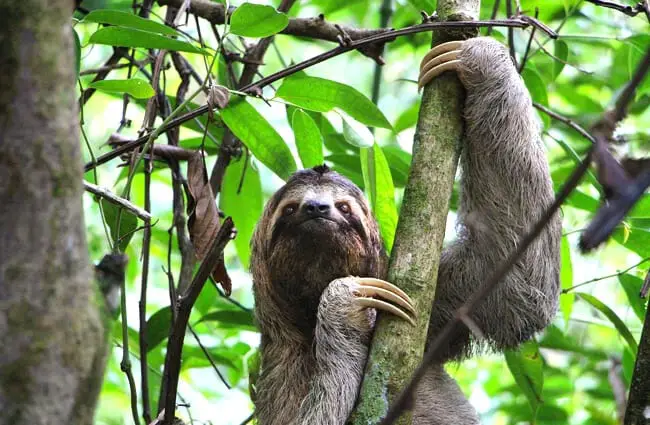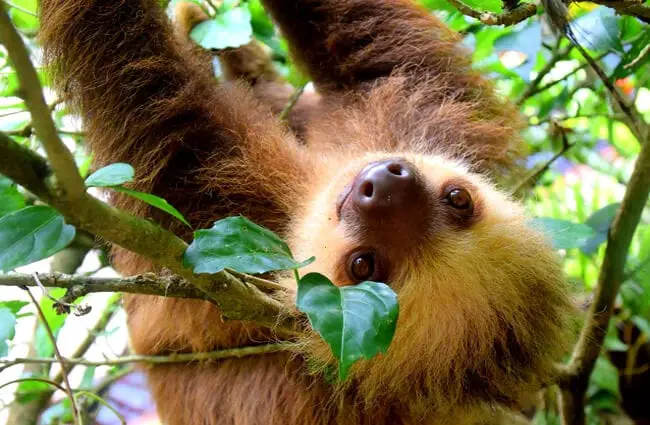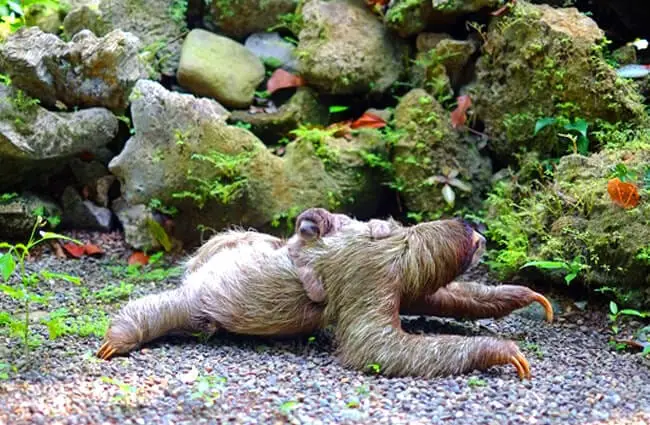In the dense, emerald canopies of Central and South American rainforests lives a creature often misunderstood, yet utterly captivating: the sloth. Far from merely being a symbol of laziness, these arboreal mammals embody a unique evolutionary strategy, a masterclass in energy conservation that allows them to thrive in a challenging environment. From their ancient lineage of colossal ground dwellers to their modern-day, slow-moving grace, sloths offer a window into the intricate dance of life in the jungle.
Prepare to delve into the fascinating world of sloths, exploring their habitats, their peculiar diets, their complex social lives, and their vital role in the ecosystem. This comprehensive guide will illuminate the secrets of these gentle tree-dwellers, providing insights for students, aspiring zoologists, nature enthusiasts, and even those who might encounter a sloth in the wild.
Understanding the Sloth: A Gentle Giant of the Canopy
Who are Sloths? A Quick Introduction
Sloths belong to the superorder Xenarthra, an ancient group of mammals that also includes armadillos and anteaters. Within Xenarthra, sloths are classified under the order Pilosa and the suborder Folivora, meaning “leaf-eaters.” There are six extant species of sloths, broadly categorized into two main families based on the number of claws on their front limbs:
- Two-toed Sloths (Megalonychidae): These include Hoffmann’s Two-toed Sloth and Linnaeus’s Two-toed Sloth. They are generally larger, have a more varied diet, and are typically more active at night.
- Three-toed Sloths (Bradypodidae): This family comprises the Pale-throated Sloth, Brown-throated Sloth, Maned Sloth, and Pygmy Three-toed Sloth. They are smaller, almost exclusively folivorous, and are primarily diurnal.
Despite their common name, the “toes” actually refer to the claws on their forelimbs. All sloths, regardless of family, possess three claws on their hind limbs. Their most defining characteristic is their incredibly slow movement, a metabolic adaptation that underpins nearly every aspect of their biology.
Where the Wild Sloths Roam: Habitat and Distribution
Sloths are exclusively found in the tropical rainforests and cloud forests of Central and South America. Their range extends from Honduras in the north, through Nicaragua, Costa Rica, Panama, Colombia, Venezuela, Ecuador, Peru, Bolivia, Brazil, and into parts of Paraguay and Argentina. Each species has a slightly different distribution, though their habitats often overlap.
These arboreal specialists spend almost their entire lives suspended upside down in the forest canopy. They prefer areas with dense foliage, providing both food and camouflage from predators. The humid, warm environment of the rainforest is crucial for their survival, as their low metabolic rate makes them susceptible to cold. They are particularly fond of trees with a good supply of their preferred leaves, often found near rivers or in secondary growth forests.
For an animal lover hoping to spot a sloth in the wild, patience is paramount. Look up, very slowly, scanning the branches for any unusual clumps of fur or a subtle movement. Sloths are masters of camouflage, blending seamlessly with moss-covered branches. Early morning or late afternoon can be good times, especially for the more diurnal three-toed sloths, when they might be sunbathing or moving between feeding trees. Focusing on areas known for sloth populations, such as national parks in Costa Rica or Panama, significantly increases the chances of a sighting.

A Journey Through Time: Sloth Evolution
The evolutionary history of sloths is far more dynamic than their modern-day demeanor suggests. Their lineage traces back millions of years to colossal ground sloths that roamed the Americas during the Cenozoic Era. These ancient relatives, such as the famous Megatherium, could weigh several tons and stood as tall as elephants, foraging on the ground for vegetation. Other notable ground sloths included Mylodon and Eremotherium.
Over millennia, as climates shifted and new ecological niches emerged, some sloth lineages adapted to an arboreal existence. This transition involved significant physiological changes, including a reduction in size, the development of long, curved claws for gripping branches, and a specialized digestive system to cope with a leaf-heavy diet. The divergence between the two-toed and three-toed sloths occurred tens of millions of years ago, leading to distinct evolutionary paths and adaptations, even though they share a common ancestor and occupy similar niches today.
The Sloth’s Menu: A Leafy Diet and Unique Digestion
Sloths are primarily folivores, meaning their diet consists almost entirely of leaves, buds, and tender shoots. Three-toed sloths are particularly specialized, often focusing on a limited number of tree species. Two-toed sloths have a slightly broader diet, occasionally supplementing leaves with fruits, insects, and small vertebrates.
The challenge with a leaf-based diet is its low nutritional value and difficulty in digestion. Leaves are tough, fibrous, and contain various defensive compounds. To overcome this, sloths have evolved a remarkable digestive system. They possess a large, multi-chambered stomach, similar to that of ruminants, which houses a complex community of symbiotic bacteria. These microorganisms break down the cellulose and other plant matter through fermentation.
This digestive process is incredibly slow, taking days or even weeks for a single meal to pass through their system. This slow digestion, combined with their low metabolic rate, means sloths derive minimal energy from their food, dictating their languid pace of life. They simply do not have the caloric intake to sustain rapid movement or high body temperatures. This unique dietary adaptation is a cornerstone of their survival strategy in the nutrient-poor environment of the rainforest canopy.

Life in the Slow Lane: Behavior and Adaptations
The Art of Slowness: Metabolism and Thermoregulation
The sloth’s defining characteristic, its slowness, is not a sign of laziness but a sophisticated energy-saving adaptation. They possess the lowest metabolic rate of any non-hibernating mammal, about 40 to 45 percent of what would be expected for an animal of their size. This allows them to subsist on their low-energy diet. To further conserve energy, sloths have a variable body temperature, which can fluctuate by several degrees throughout the day, often matching the ambient temperature. They frequently bask in the sun to warm up, a behavior crucial for their digestion and overall physiological function.
Masters of Camouflage: Fur and Algae
Sloth fur is unique, growing in the opposite direction to most mammals, from their extremities towards their back. This allows rainwater to run off easily when they are hanging upside down. More remarkably, their coarse, grooved fur provides a microhabitat for a diverse ecosystem of organisms, most notably symbiotic green algae. This algae provides excellent camouflage, helping sloths blend in with the mossy branches of their arboreal home. Recent research even suggests that sloths might absorb nutrients from consuming this algae, adding another layer to their complex diet. The fur also hosts various invertebrates, including sloth moths and beetles, which complete part of their life cycle within the sloth’s coat.
The Weekly Descent: A Risky Ritual
One of the most peculiar and risky behaviors of the three-toed sloth is its weekly descent from the canopy to the forest floor to defecate. This journey is fraught with danger, as sloths are highly vulnerable to predators on the ground. The exact reasons for this ritual are still debated among scientists. Theories include:
- Nutrient Cycling: The sloth deposits its waste at the base of its preferred tree, potentially fertilizing the tree and ensuring a continued food supply.
- Communication: The scent of the faeces might serve as a form of communication with other sloths.
- Moth Symbiosis: The sloth moths living in the fur lay their eggs in the fresh faeces, and the larvae develop there before returning to the sloth. This symbiotic relationship might provide the sloth with additional nitrogen or other benefits.

Love in the Canopy: Mating and Reproduction
Sloths are generally solitary animals, coming together primarily for mating. The reproductive process is as unhurried as the sloths themselves. Three-toed sloth females signal their readiness to mate with a distinctive, high-pitched call, often described as a “scream” or “squeal,” which attracts males from a distance. Two-toed sloths are less vocal, relying more on scent marking.
After mating, the gestation period is remarkably long, ranging from around six months for three-toed sloths to up to eleven and a half months for two-toed sloths. Females typically give birth to a single offspring, which is born fully furred and with open eyes. The newborn immediately clings to its mother’s belly, where it will spend the first several months of its life. The mother provides milk and protection, and the infant gradually learns to navigate the canopy and identify edible leaves by sampling food from its mother’s mouth.
The bond between mother and infant is strong, with the young sloth remaining dependent for five to six months, sometimes even longer. This slow development mirrors the sloth’s overall life strategy, ensuring the young are fully equipped for their challenging arboreal existence before venturing out on their own.
Sloths in the Web of Life: Ecosystem Role and Interactions
While sloths may seem passive, they play a subtle yet important role in the rainforest ecosystem. As primary consumers, they help regulate plant growth by consuming leaves. Their slow digestion and occasional ground descents might contribute to nutrient cycling, albeit on a small scale. They are also part of the food chain, serving as prey for apex predators such as jaguars, ocelots, and the formidable harpy eagle, which plucks sloths directly from the canopy.
Beyond predator-prey dynamics, sloths engage in fascinating symbiotic relationships. The most well-known is with the algae and moths that inhabit their fur, as previously discussed. These interactions highlight the sloth as a miniature ecosystem in itself. Furthermore, as a species highly dependent on intact forest canopy, sloths can be considered indicator species. Their presence and health reflect the overall health and biodiversity of the rainforest, making their conservation crucial for the broader ecosystem.

Sloths and Humanity: Culture, Conservation, and Coexistence
Sloths in Human Culture
Historically, sloths have often been depicted as symbols of laziness or apathy, a misconception stemming from their slow movements. However, in recent years, their unique charm and gentle nature have led to a surge in popularity. Sloths are now frequently featured in documentaries, animated films, and social media, often portrayed as endearing and peaceful creatures. Indigenous cultures in their native range have long held sloths in their folklore, sometimes revering them, other times associating them with spirits of the forest.
Interacting with Wild Sloths: A Hiker’s Guide
For hikers and nature enthusiasts encountering a sloth in the wild, the most important rule is to observe from a respectful distance. Sloths are wild animals, and while generally docile, they can defend themselves if threatened. Their long claws, though primarily for climbing, can inflict a painful scratch. Here are key guidelines:
- Maintain Distance: Use binoculars or a telephoto lens for close-up views. Never approach a sloth too closely.
- Do Not Touch or Feed: Human contact can stress sloths, transmit diseases, and interfere with their natural behaviors. Feeding them inappropriate foods can be harmful.
- Observe, Do Not Disturb: Avoid loud noises or sudden movements that might startle the animal.
- Report Injured or Stranded Sloths: If you find a sloth on the ground, injured, or in a dangerous situation (e.g., on a road), do not attempt to handle it yourself. Contact local wildlife rescue organizations or park authorities immediately.
- Support Conservation: Choose eco-tourism operators who prioritize animal welfare and habitat protection.
Conservation Status and Threats
While many sloth species are currently listed as “Least Concern” by the IUCN, some, like the Pygmy Three-toed Sloth, are critically endangered. All sloths face significant threats, primarily habitat loss and fragmentation due to deforestation for agriculture, logging, and urban development. Other dangers include:
- Road Accidents: As forests are fragmented, sloths are forced to cross roads, making them vulnerable to vehicle collisions.
- Power Lines: Sloths often mistake power lines for vines, leading to electrocution.
- Illegal Pet Trade: Despite their unsuitability as pets, sloths are sometimes illegally captured and sold, often leading to their demise.
- Human Interference: Uninformed tourists or locals attempting to “rescue” or interact with sloths can cause stress and injury.
Conservation efforts focus on protecting and restoring rainforest habitats, creating wildlife corridors, and educating local communities and tourists about responsible interaction with wildlife.

Caring for Captive Sloths: A Zookeeper’s Perspective
Caring for sloths in a captive environment, such as a zoo or rescue center, requires specialized knowledge and dedication to replicate their natural conditions as closely as possible. Zookeepers play a crucial role in ensuring their welfare.
Creating the Ideal Environment
- Enclosure Design: Sloth enclosures must be arboreal, featuring numerous sturdy branches, ropes, and climbing structures at varying heights. They need ample space to move vertically and horizontally.
- Temperature and Humidity Control: Maintaining a warm, humid environment (typically 24-30°C and 60-80% humidity) is vital for their low metabolic rate and digestive health.
- Dietary Considerations: Providing a diet rich in fresh, appropriate leaves (e.g., hibiscus, ficus, cecropia) is paramount. This often requires sourcing from specific, non-toxic plants. Supplements, such as chopped vegetables, fruits, and a specialized leaf-eater biscuit, may be offered to ensure a balanced nutritional intake.
Health and Welfare
- Regular Veterinary Checks: Routine examinations, including dental checks, weight monitoring, and faecal analysis, are essential to detect health issues early.
- Monitoring Digestion: Given their unique digestive system, zookeepers must closely monitor their faecal output and consistency.
- Mental Stimulation: While sloths are not highly active, enrichment items like puzzle feeders, new climbing structures, and varied foliage can provide mental stimulation.
- Hygiene: While their fur naturally hosts algae, enclosures must be kept clean to prevent bacterial infections.
What to Avoid
- Over-handling: Sloths are easily stressed by excessive human interaction. Handling should be minimized and only performed when necessary for veterinary care or enclosure maintenance.
- Inappropriate Diet: Feeding sloths foods not part of their natural diet can lead to severe digestive problems and nutritional deficiencies.
- Lack of Climbing Opportunities: Without sufficient arboreal structures, sloths can develop muscle atrophy and other health issues.
- Stressors: Loud noises, sudden movements, or the presence of unfamiliar animals can cause significant stress.
Fascinating Facts About Sloths
Beyond their slow pace, sloths possess a host of intriguing characteristics:
- Aquatic Acumen: Despite their arboreal lifestyle, sloths are surprisingly excellent swimmers, often moving through water three times faster than they do on land. They can hold their breath for up to 40 minutes, longer than dolphins or seals, by slowing their heart rate.
- Head-Turning Ability: Three-toed sloths can rotate their heads almost 270 degrees in either direction, thanks to an extra two vertebrae in their neck. This allows them to scan their surroundings for predators and food without expending energy by moving their bodies.
- Iron Grip: A sloth’s grip is incredibly strong. They can hang upside down for hours without effort, and their claws are so powerful that they can remain clinging to a branch even after death.
- Sleep Patterns: While captive sloths might sleep up to 15-20 hours a day, wild sloths are believed to sleep closer to 8-9 hours, similar to humans.
- Nocturnal vs. Diurnal: Three-toed sloths are generally diurnal (active during the day), while two-toed sloths are primarily nocturnal.
- Unique Fur Structure: The grooved structure of their hair is not only for algae but also helps wick away water, preventing them from becoming waterlogged in the rainy rainforest.
The sloth, with its unhurried movements and enigmatic charm, is a testament to nature’s incredible diversity and adaptability. Far from being a symbol of idleness, it represents a highly specialized and successful evolutionary path, perfectly attuned to its rainforest home. Understanding and appreciating these gentle creatures is not just about learning about a single species, but about recognizing the delicate balance of ecosystems and our shared responsibility to protect them. The next time you encounter an image or video of a sloth, remember the complex, fascinating life unfolding in the slow lane of the canopy, a life worth preserving for generations to come.

![Red Angus Closeup of a beautiful Red Angus cowPhoto by: U.S. Department of Agriculture [pubic domain]https://creativecommons.org/licenses/by/2.0/](https://animals.net/wp-content/uploads/2020/03/Red-Angus-4-238x178.jpg)




![Red Angus Closeup of a beautiful Red Angus cowPhoto by: U.S. Department of Agriculture [pubic domain]https://creativecommons.org/licenses/by/2.0/](https://animals.net/wp-content/uploads/2020/03/Red-Angus-4-100x75.jpg)

